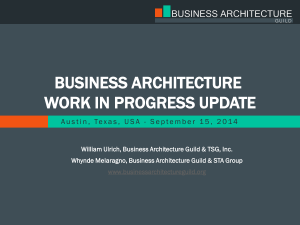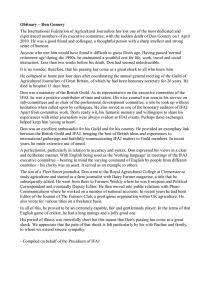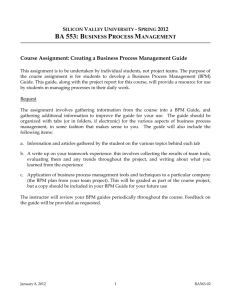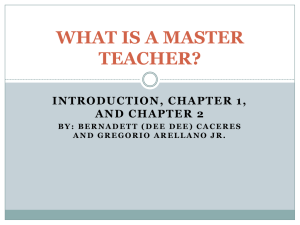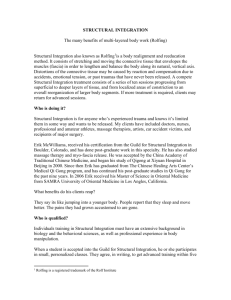BUSINESS ARCHITECTURE AND BPM ALIGNMENT
advertisement
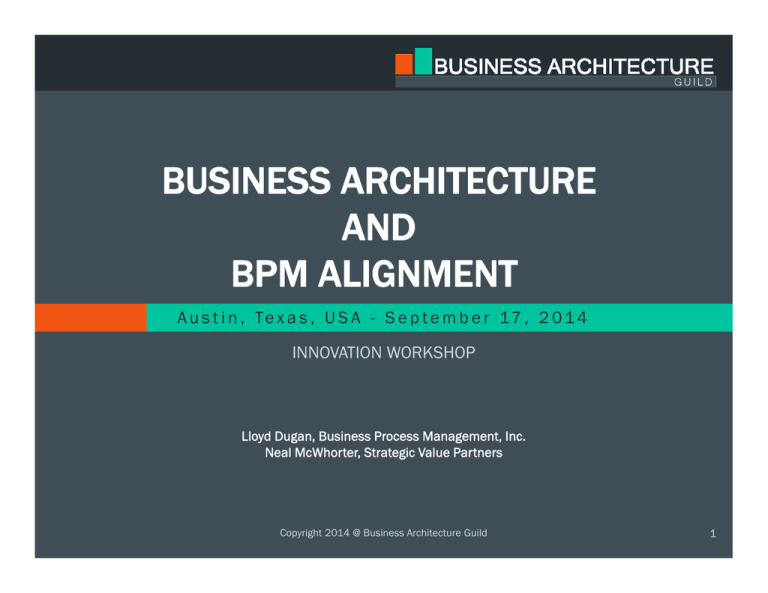
BUSINESS ARCHITECTURE AND BPM ALIGNMENT A u s t i n , T e x a s , U S A - S e p t e m b e r 17 , 2 0 1 4 INNOVATION WORKSHOP Lloyd Dugan, Business Process Management, Inc. Neal McWhorter, Strategic Value Partners Copyright 2014 @ Business Architecture Guild 1 TEAM OVERVIEW Copyright 2014 @ Business Architecture Guild 2 BPM ALIGNMENT COLLABORATIVE TEAM PROBLEM STATEMENT AND GOAL One of the key issues facing practitioners that are attempting to establish a Business Architecture (BA) practice is how to reconcile some of its concepts with those of other related analytic practices. This issue is perhaps most frequently encountered when organizations attempt to reconcile Business Architecture with existing practices in their Business Process Management (BPM) areas. The BPM-BA Alignment Group is striving to provide a foundation for organizations to use to begin building linkages between these two analytic areas by defining and illuminating the differences and touch points between these two related disciplines and associated practice areas. This foundation will recognize that many BPM practitioners, particularly with respect to process modeling, are already doing what is described here. 9/12/2014 Copyright 2014 3 BPM ALIGNMENT COLLABORATIVE TEAM DELIVERABLES COMPLETE Updated Section 3.4 of BIZBOK® Guide (Version 4.0), “Business Architecture and Business Process Modeling & Management” Delivered webinar June 2014 PLANNED Forthcoming Position Papers on relationship between BA and BPM First version of “Business Architecture and BPM - Differentiation and Reconciliation” whitepaper is released on website, but is currently under review by BPM Community and subject to change Related Clarification in Business Architecture Framework and Metamodel Other BIZBOK® Guide Section 3.4 changes TBD Other priorities TBD based on community feedback today 9/12/2014 Copyright 2014 4 BPM ALIGNMENT COLLABORATIVE TEAM TEAM MEMBERS Member Company Role William Ulrich TSG, Inc. Collaborative Team Mentor Whynde Melaragno STA Group Collaborative Team Lead Neil Bazely SMS Management and Technology Collaborative Team Co-Lead Lloyd Dugan Business Process Management, Inc. Primary Contributor Tom Dwyer Salient Process Content Reviewer Yojana Ganduri Aetna Content Reviewer Neal McWhorter Strategic Value Partners Primary Contributor Jim Rhyne Thematix Content Reviewer Mike Rosen Wilton Consulting Group Content Reviewer Elaine Wong Health Care Service Corporation Content Reviewer 9/12/2014 Copyright 2014 5 BPM AND BUSINESS ARCHITECTURE ALIGNMENT OVERVIEW Copyright 2014 @ Business Architecture Guild 6 DEFINITIONS Copyright 2014 @ Business Architecture Guild 7 BUSINESS MODEL VS. OPERATING MODEL Business Model: A Business Model describes the rationale of how an organization creates, delivers, and captures value. Source: Alexander Osterwalder and Yves Pigneur, Business Model Generation, SelfPublished, 2010, Page 14; incorporated into Section 3.3 of the BIZBOK v3.5 BA concepts of Value Stream and Capability should emerge from this context. Operating Model: An Operating Model is an abstract representation of how an organization operates across process, organization and technology domains in order to accomplish its function. Source: Wikipedia (http://en.wikipedia.org/wiki/Operating_model#cite_note-1), cited as coming from Marne de Vries, Alta van der Merwe, Paula Kotze and Aurona Gerber. (2011) A Method for Identifying Process Reuse Opportunities to Enhance the Operating Model. 2011 IEEE International Conference on Industrial Engineering and Engineering Management; will be incorporated into the BIZBOK v4.0. BA and BPM concept of Business Process should emerge from this context. Copyright 2014 @ Business Architecture Guild 8 DEFINING BUSINESS ARCHITECTURE (BA) The most fundamental aspect of Business Architecture is that it represents a business. Business Architecture is defined as: “A blueprint of the enterprise that provides a common understanding of the organization and is used to align strategic objectives and tactical demands.“ – see BIZBOK 3.5, Section 2.4, p. 115 The practice of Business Architecture separates the concerns of: • What we do (capabilities), from… • Who does it (organization), from… • How it’s done (process), from… • The information that’s needed, from … • The systems that are used, and so on. These individual concepts and relationships are stored and managed in a knowledge base, which is built on incrementally. Copyright 2014 @ Business Architecture Guild 9 DEFINING BUSINESS PROCESS MANAGEMENT (BPM) Business Process Management (BPM) is a term that has regrettably come to mean too many different things to too many different but related communities (process automation, process modeling, process improvement, enterprise architecture, etc.), with no one community fully and consistently defining BPM as something that unifies and integrates its interdisciplinary nature but rather all communities balkanizing it instead. Discussions on Linked-In’s BPM Guru, BPM.COM Forum, Workflow Management Coalition (WfMC) members, and Association of BPM Professionals (ABPMP) Forum was used to produce a consensus among many long-time practitioners and thought leaders: “Business Process Management (BPM) is a discipline involving any combination of modeling, automation, execution, control, measurement and optimization of business activity flows, in support of enterprise goals, spanning systems, employees, customers and partners within and beyond the enterprise boundaries.” – see http://social-biz.org/2014/01/27/one-common-definition-for-bpm/ Copyright 2014 @ Business Architecture Guild 10 DEFINING A BUSINESS PROCESS A Value-Output One: “Process is a technical term with a precise definition: an organized group of related activities that together create a result of value to the customer.” – From Hammer & Champy, Reengineering the Corporation: A Manifesto for Business Revolution, 1993 A Functional One: “In definitional terms, a process is simply a structured, measured set of activities designed to produce a specific output for a particular customer or market.” – From Thomas H. Davenport, Process Innovation: Reengineering Work Through Information Technology, 1993 An Operational One: “A set of one or more linked procedures or activities, which collectively realize a business objective or policy goal, normally within the context of an organizational structure defining functional roles and relationships.” – From the Workflow Management Coalition (www.wfmc.org) and cited by “In OMG’s OCEB Certification Program, What Is the Definition of a Business Process? “about the OMG Certified Expert in BPMN (OCEB) Program on the Object Management Group (OMG) website (http://www.omg.org/oceb/defbusinessprocess.htm) Copyright 2014 @ Business Architecture Guild 11 COMMON CHARACTERISTICS OF A PROCESS ACROSS MODELING LANGUAGES Common Characteristics that Define Process Boundaries • Span of Control – A process will have a span of control that defines the controlling context that governs or enforces its flow, its application of business logic, the assignment of performers, etc. • Decomposition – Decomposition of a process is essentially a decomposition of a span of control, where a higher-level expression of execution passes to/receives from a lower-level one. • Trigger and End States – A process when instantiated has a specific set of circumstances that constitutes a definitive beginning, and another set that constitutes a definitive end or ends. • Exchange Interfaces – A process will have interfaces through which exchanges occurs between the span of control of a specific process and that of other processes. Copyright 2014 @ Business Architecture Guild Other characteristics could be considered, but these provide a sound basis for evaluating and differentiating the degree of appropriateness for designating an observed concept as a Business Process and using a Process Modeling Language to describe it in a Process Model 12 TREATMENT OF VALUE STREAMS & BUSINESS PROCESSES Copyright 2014 @ Business Architecture Guild 13 VALUE STREAM AS A BUSINESS PROCESS? Process Boundary Characteristics Degree of Appropriateness for Process Modeling Span of Control Low – Value Stream may have more than one span of control Decomposition High – Value Stream is composed of Value Stages, which can decompose Trigger and End States Low – Value Stages have entry/exit criteria, but these are not really the same Exchange Interfaces Low – Value Stages do not exchange information with other Value Stages Copyright 2014 @ Business Architecture Guild 14 RELATIONSHIP BETWEEN VALUE STREAM & BUSINESS PROCESSES A Value Stream breaks down into related but not necessarily sequential Value Stages with separate entry/exit criteria, while a Process describes an operational view of activities and events that execute per defined semantics. The value output from a Process contributes to a Value Stream via one or (typically) more Value Stages that are supported by the operations of one or more Processes. Aspects of one may map to another, e.g., a Value Streams Heat Map may point to Processes, and vice-versa. Respective granularities are different, which require a mapping between the two but not a new way of Process Modeling!!! Copyright 2014 @ Business Architecture Guild 15 VALUE STREAM IN BUSINESS ARCHITECTURE In the Business Architecture Framework proposed by the BA Guild, a Value Stream consists of Value Stages, all of which are associated with a Value Item that is the realized value Copyright 2014 @ Business Architecture Guild 16 DEFINITIONAL GRANULARITIES – VALUE STREAM VS. BUSINESS PROCESSES Blocked Out for Group Exercise At End of Presentation Processes have operational elements that cross over one or more Value Streams Value Streams are achieved through the execution of operational elements from one or more Processes Copyright 2014 @ Business Architecture Guild 17 TREATMENT OF CAPABILITIES & BUSINESS PROCESSES Copyright 2014 @ Business Architecture Guild 18 CAPABILITIES AS A BUSINESS PROCESS? Process Boundary Characteristics Degree of Appropriateness for Process Modeling Span of Control Low – Capability may have more than one span of control Decomposition High – Capability may be decomposed of increasingly finer-grained Capabilities Trigger and End States Low – Capability has no concept of flow internally or across other Capabilities Exchange Interfaces Low – Capability exists in a context of Information, Organization , Value Stream, and Resources, but these are not the same as exchanges of data Copyright 2014 @ Business Architecture Guild 19 RELATIONSHIP BETWEEN PROCESS AND CAPABILITIES A Capability may decompose into smaller Capabilities that are related but not necessarily sequential, while a Process describes an operational view of activities and events that execute per defined semantics. The functionality from a Process enables one or (typically) more decomposed Capabilities through execution of operations for one or more Processes. Aspects of one may map to another, e.g., a Capabilities Heat Map may point to Processes, and vice-versa. Respective granularities are different, which require a mapping but not a new way of process modeling!!! Copyright 2014 @ Business Architecture Guild 20 CAPABILITY MAP IN BUSINESS ARCHITECTURE In the Business Architecture Framework proposed by the BA Guild, a Capability may decompose into increasingly finer-grained Capabilities Copyright 2014 @ Business Architecture Guild 21 DEFINITIONAL GRANULARITIES – CAPABILITIES VS. BUSINESS PROCESSES Blocked Out For Group Exercise At End of Presentation Processes have operational elements that cross over one or more Capabilities Capabilities are implemented by operational elements from one or more Processes Copyright 2014 @ Business Architecture Guild 22 PRACTICE GUIDANCE FOR BPM-BA ALIGNMENT IN MODELING BUSINESS PROCESSES Copyright 2014 @ Business Architecture Guild 23 MODELING GUIDANCE A Value Stream should not be modeled as an E2E high-level process as an artifact of the Business Architecture (though as a standalone visualization it may have value), but map Business Processes (understood as operational flow descriptions) to Value Streams, and vice-versa. A Capability should not be modeled as an E2E high-level process as an artifact of the Business Architecture (though as a standalone visualization it may have value), but map Business Processes (understood as operational flow descriptions) to Capabilities, and vice-versa. A Business Process should be modeled as an operational flow description, using a formal modeling language that can support mapping at the model data level to other concepts in a Business Architecture (e.g., with Heat Maps), which will give BPM better business alignment and a BA greater depth of operational understanding. Copyright 2014 @ Business Architecture Guild 24 USAGE OF MODELS IN PRACTICE Identification of potential process redundancies (unwarranted multiple processes for doing or realizing the same thing), as evidenced by seemingly unnecessary multiple mappings. Discovery of poorly understood competitive variations (previously unknown multiple processes to support business variations), as evidenced by presumably necessary multiple mappings. Identification of organic inconsistencies across processes (relationships that should be present across all process variants not being present), as evidenced by missing mappings. Support for process improvement through better targeting of BPM-driven efforts (via mappings among Business Processes, Value Streams and Capabilities, as well as other concepts). Copyright 2014 @ Business Architecture Guild 25 TEAM INTERACTION Copyright 2014 @ Business Architecture Guild 26 LET’S DO SOME MAPPING TOGETHER. WHY: TO GIVE YOU AN APPRECIATION FOR THE EFFORT INVOLVED IN MAPPING PROCESS TO ARCHITECTURE. HOW: 1. Reference Example Slides #17 and #22 of Presentation. 2. Reference Process Description and BPMN Model Provided. 3. Map Processes to Identified Value Stream (Value Stages). 4. Map Processes to Identified Capabilities. 9/12/2014 Copyright 2014 27 PROCESS DESCRIPTION Once the Conduct Mail Campaign process is started, the Prepare Customer Lists task pulls customer lists from the applicable databases to provide addressees for the mailing campaign. Based on this information, the Produce Customer Items task assembles the requisite items for the customers targeted in the mailing campaign. For each identified customer, the Mail Customer Items task mails the items to the customer, the Record Customer Response task records any response received from the customer, and the Perform Customer Follow-up task performs interactive follow-up with the customer. These three tasks occur in parallel collectively as part of the customer mailing, which has a time limit on how long the company will hold open any follow-up. 9/12/2014 Copyright 2014 28 BPMN MODEL Bonus Discussion: What are the operational characteristics of this process? 9/12/2014 Copyright 2014 29 MAP PROCESS TO CAPABILITIES 9/12/2014 Copyright 2014 30 MAP PROCESS TO VALUE STAGES 9/12/2014 Copyright 2014 31 BRING US YOUR PROBLEMS. WHY: TO MAKE THE CONCEPTS WE’VE DISCUSSED REAL. HOW: SHARE A SITUATION OR CHALLENGE RELATED TO PROCESS AND BUSINESS ARCHITECTURE FOR US TO SOLVE TOGETHER. 9/12/2014 Copyright 2014 32 TELL US YOUR NEEDS. WHY: HELP US SET PRIORITIES FOR THE NEXT HORIZON. HOW: TELL US: 1. Who are the key audiences we need to target? 2. What BPM / Business Architecture Alignment topics does each key audience need clarity on? 3. What audiences and topics are highest priority? 9/12/2014 Copyright 2014 33

